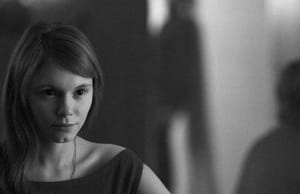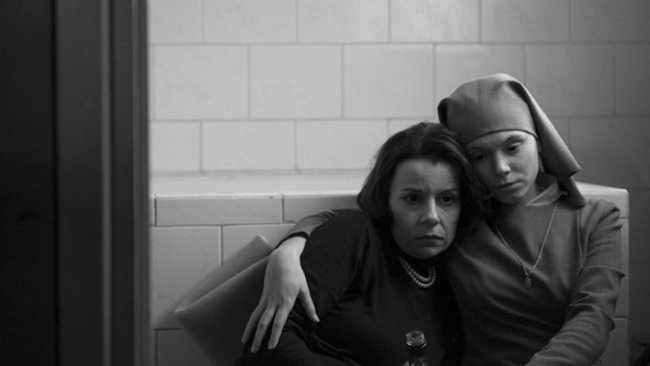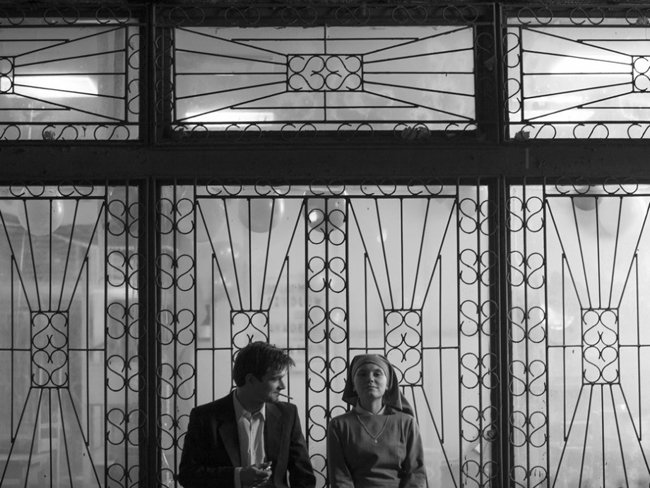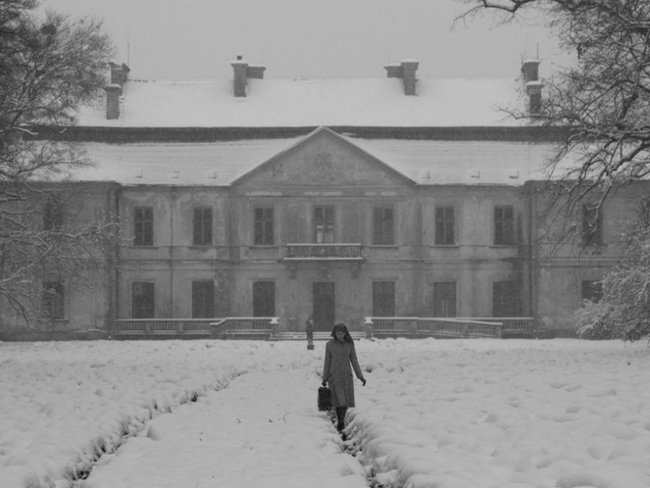
Amidst the celebrity star power and buzz of this past January’s Sundance Film Festival it was encouraging to discover that an 80-minute, black and white, Polish-language film starring an inexperienced first-time actor would turn out to be the most haunting, provocative and visually gorgeous selection of the fest.
It isn’t the first time Polish-born, British-trained filmmaker Pawel Pawlikowski has shown his work at Sundance. In 2000, the director’s sophomore feature, The Last Resort, premiered to critical acclaim, later earning Pawlikowski the Most Promising Newcomer award at the 2001 BAFTAs.
Ida stunned Sundance audiences with its Truffaut-like austerity and its starkly beautiful compositions, which were shot in luminous monochrome. It is Pawlikowski’s first Polish-language film and the first time he has focused his lens on his homeland. After a screening at the New York Jewish Film Festival he told the audience, “I wanted to do a film about a Poland that doesn’t exist anymore.”
Set in 1962 Communist Poland, Ida focuses on Anna (arresting newcomer Agata Trzebuchowska), a young woman raised in a convent as an orphan who is preparing to become a nun. But before she can take her vows she is told by the Mother Superior that she must connect with a relative she never knew existed. The woman turns out to be her mother’s sister, Wanda (veteran actress Agata Kulesza), a highly-placed, take-no-prisoners judge whose impulsive behavior has become an embarrassment to her party superiors. Together, the promiscuous and hard-drinking aunt and innocent teen set out on a road trip to discover what actually happened to Anna’s parents, Jews that died during the war.
Tender, bleak and, at times, unexpectedly humorous, Ida has an emotionally immersive quality that sticks with you long after the theater lights come up. This is no easy task given that Pawlikowski has composed the majority of his scenes in wide angle, often uninterrupted, shots. It’s a daring approach for what is essentially an intimate, two-character drama.
While at Sundance, I chatted with Pawlikowski about his risky approach to making Ida, as well as his general approach to filmmaking. Our conversation has been edited for length and clarity.
Jeff Meyers, MovieMaker Magazine (MM): The compositions in Ida are absolutely gorgeous. I’m interested in your visual approach because it’s not easy to create intimacy with a widescreen composition.
Pawel Pawlikowski (PP): Well, the whole film was a kind of tightrope walk, you know. But I wanted very much for the film to not sell its emotions to cheaply. I find that happens too much in cinema, especially with the topic we’re dealing with. There’s a tendency not to trust the audience. Although the images were static and wide very often, I found a lot of emotion in that. I tried to make those shots very emotional, but not in a rhetorical way where you just kind of follow the actors emotions, but to have its own emotions. There’s not a single shot that doesn’t convey some kind of melancholy nostalgia or absurdity or something. It wasn’t like I was trying to alienate the audience.
MM: There are not a lot of filmmakers who have the patience or the confidence to maintain a wide screen composition. When you choose that shooting format are you giving yourself coverage?
PP: No, it really was a kind of tightrope. You know you have the ideal shot, that it is the ideal angle, so you let the actors function in that space at the same time in their own way.
MM: But there were some long uninterrupted takes. You didn’t give yourself a way out?
PP: No. It focuses everybody’s mind because we won’t be able to cut ourselves out of trouble. You know there’s not going to be a cut. It’s really difficult to light. But the good thing is you don’t have to relight each scene. You like one angle and you try to light it as interestingly and suggestively as you can – realistically but also lyrically. And then you make the actors perform in that space contemporaneously, the two of them or three of them.
MM: So in many ways it’s like a stage production.
PP: Yes there’s a bit of that. But in theater there’s always a lot of dialogue that conveys information or conveys feelings or thoughts. Whereas here, that was sort of implied. It’s the implied image or the body language of the actors.
MM: I was struck by how deliberate the dialogue was. It takes a ruthless hand to pare everything down to that kind of essential simplicity and still end up with a story that’s so rich. Is there a process that you go thorough in the writing where you’re finding ways to minimize?
PP: Yes, but it helps to get the right structure so the dialogue doesn’t have to carry the information. Usually a film full of dialogue has to seed in information, and it usually ends up being bad dialogue or prosaic dialogue. I wanted dialogue that really cut through that and is as expressive as the images.
For that you need to find the right structure for the story and I didn’t find it until just before the filming started. The original script was a little bit misshapen so it needed dialogue to compensate. But if you have a structure that’s organically put together, the dialogue is not required to convey information or conveys it in minimal way. So when you rehearse, and even when you shoot, you hear that this is false. Or you find that the line is not just false but it’s just not interesting or expressive so you cut it out. Sometimes you think, “Okay, this line’s a little ridiculous or cliché so lets try another line… or maybe we don’t need a line at all.”
The important thing is that you’re in the moment during preparation and shooting, all the time. I constantly distill, add, distill, add. It’s very unscientific and not very industrial. But I just kind of rely on my own – not just my own, but my actors’ – instability. I draw them into this game where we’re constantly revising, improving, adding, taking a way. It’s like a soup where you’re constantly adding and taking things away. Well, you can’t take things out of soup. It’s really like a musical process, like trying to create a kind of—
MM: Like jazz.
PP: Like jazz, yeah. But like jazz that settles into a composition that can’t be played in any other way.
MM: I understand that your lead actress, Agata Trzebuchowska, never acted before. What advice would you give to a director who is working with a lead that doesn’t know their way around a film set? What’s your approach?
PP: Well, the main thing is to cast well. That is about 90 percent of the job. I had a lot of young actresses and drama students that I tested, and I was really unhappy [with them]. By elimination I arrived at this girl, who I found at a café, who never acted before, who didn’t even want to act. But there was something very right about the way she was. Not externally, but her character. It wasn’t a spectacular challenge to make her perform this part because I thought she was already very close to the part. Although the girl didn’t actually believe in God, and had no taste for religion whatsoever. So that was a bit of a challenge.
MM: How did you make that introduction? I mean, you’re talking to someone you just met in a café?
PP: Well, she’d seen my films, so she was kind of interested in working with me. And the fact that not only hadn’t she acted, but she wasn’t keen on acting, which is very rare these days, made me convinced that she was the right person for this part. Because the part involves somebody who’s not histrionic in the least, who doesn’t have a theatrical bone in her body, who’s totally contained with what is happening inside, and doesn’t externalize it. So basically she was in the right ballpark from the word “Go.”
And then the important thing on set was that she didn’t get overwhelmed by the situation. Generally, I keep my sets very small and friendly and collaborative, so everyone kind of feels like they’re responsible for the film. She was also a very strong and intelligent girl, so it wasn’t an impossibility to make her bloom in front of the camera. The actress she played opposite was very helpful too: Agata Kulesza, who is very experienced, very sure of her own craft. She did all her best not to overwhelm the young girl. I mean, Agata Kulesza is quite well known, so she’s a bit of a star, but definitely not ‘starry.’ With most of my films I’ve worked with people who never really acted before, so I try to work around them and see how I can bring out the most in them.
MM: You’ve worked with production crews from all around the world, do you find there’s a kind of distinguishing personality when you’re working with one kind of crew versus another?
PP: Yeah, in Britain I tend to work with—if I do another film in Britain—with people I’ve made relationships with over the last few films. But the general trend in Britain is for a crew [that isn’t interested in the art house]… you work with people who won’t actually go and see your film. They would much rather be making a kind of American big budget movie in Pinewood than working on your shitty little film, and they’re good professionals, but they don’t think or talk cinema. They’re great sound men or great this or that, but you can’t talk to them about cinema. After work, they go to the pub and talk about football, which, luckily, I also love, so we have something in common.
In France, it was a very different experience. The crew was not only competent but they were incredibly into cinema. Each member of the crew had seen most of great cinema, and they were really into a foreigner like me doing something, and doing it differently, seeing the world differently. It was a very sensitive crew. I had a gaffer who was a kind of photographer in his own right, who exhibited his work. The grip was not new to cinema, but went to theater. I hardly met such a civilized and sensitive set of people in my life.
In Poland, people are also into film. They’re not just technicians. Poles have this thing about being very opinionated, including me, so you get a lot of opinions whether you like something or not.
MM: You mentioned how you like to be collaborative. What does that mean for you as a collaborator?
PP: Well, I definitely don’t like opinionated [crews]. Opinionated means having opinions rather than entering your game; collaboration literally means that people join me and my game.
MM: Right, but they’re still contributing.
PP: They’re contributing, but they enter the space and they know what my take is, what my taste is, and they like it, and they enjoy it, and they contribute, but on terms with my film rather than their ego. As soon as there’s a tiny bit of ego —“look what I’m doing”— the whole thing is ruined because one ego fucks everything up. I’m much more of a totalitarian brain, so people who want to work with me kind of know that, so they enter this and they help me pull this thing off, but I’m totally responsible for the film.
MM: So, do you have a manner in which you make that collaboration an invitation for ideas?
PP: Of course, once you’ve established what the tone is—even just by casting well. You cast people who you want to work with, who are intelligent, who are sensitive, or who are specific as to what they can do. They are chosen so you know that their imagination is going to work well in that space. You try to choose members of the crew who are also generous, have no ego problems, who are not just interested in technology or the technical aspects of things. And then once they deserve to be listened to—it’s like a friendship, but with love. It’s not like anybody can enter off the streets and be your friend. You’ve got to get to know them, they’ve got to get to know you, and some spark emerges. Or it doesn’t emerge.
MM: Have you ever run into a situation where…
PP: …it didn’t work? Well, yes, my first director of photography. He didn’t feel the film, so he dropped out on the first day. He didn’t like the static shots, the wide stuff, the framing, so basically it didn’t work. I ended up shooting the film with a young chap who was the camera operator, and he never made a film before, this was his debut.
MM: Well, how did that conversation go?
PP: When my director of photography dropped out, I rang my director of photography friends—they were all busy—so there was this young guy, who I had never seen any of his work, who looked liked a student, I never worked with him before. But he had been there during the prep and knew what I was after. And then he came up trumps. The great thing about him was that he didn’t have any track record. His name is Lukasz Zal. It was his first job. He was totally brave, so when I asked him to frame like this, or like that… some DPs would have felt, “oh fuck, there goes my reputation.” Whereas he didn’t have a reputation to defend, so he was totally free and easy and energetic and enthusiastic. At the beginning he was just this boy, but after a week in he was another mind working on the film and totally entered the game.
The crazy thing about having a film that you really feel is that the film rejects what doesn’t belong to it. Sometimes I had shots which immediately made me think, “Fuck, that’s not from this film, what are we doing?” Or I had one main source of light in most shots and whenever we tried to get away from it, it just didn’t work. Or we moved the camera or tried a close-up that we framed up and the film rejected it. Or even with some bits of dialogue. At some point, once you’ve worked out what your film is, the film has its own logic, and you just have to be faithful to it. MM
Ida opens in theaters in Los Angeles and New York today, May 2, 2014, courtesy of Music Box Films.
To subscribe to MovieMaker Magazine, click here.




